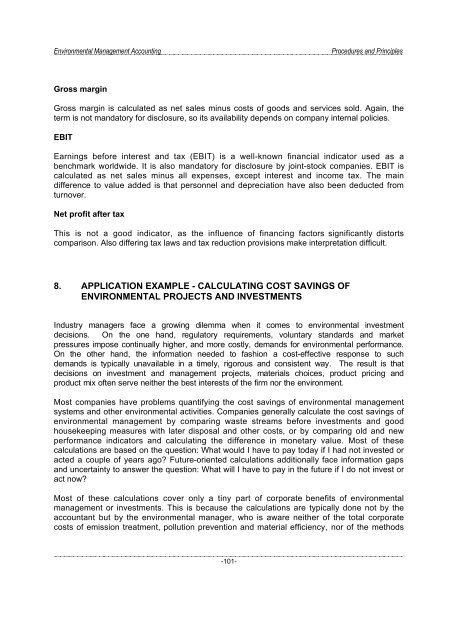Environmental Management Accounting Procedures and Principles
Environmental Management Accounting Procedures and Principles
Environmental Management Accounting Procedures and Principles
Create successful ePaper yourself
Turn your PDF publications into a flip-book with our unique Google optimized e-Paper software.
<strong>Environmental</strong> <strong>Management</strong> <strong>Accounting</strong><br />
<strong>Procedures</strong> <strong>and</strong> <strong>Principles</strong><br />
Gross margin<br />
Gross margin is calculated as net sales minus costs of goods <strong>and</strong> services sold. Again, the<br />
term is not m<strong>and</strong>atory for disclosure, so its availability depends on company internal policies.<br />
EBIT<br />
Earnings before interest <strong>and</strong> tax (EBIT) is a well-known financial indicator used as a<br />
benchmark worldwide. It is also m<strong>and</strong>atory for disclosure by joint-stock companies. EBIT is<br />
calculated as net sales minus all expenses, except interest <strong>and</strong> income tax. The main<br />
difference to value added is that personnel <strong>and</strong> depreciation have also been deducted from<br />
turnover.<br />
Net profit after tax<br />
This is not a good indicator, as the influence of financing factors significantly distorts<br />
comparison. Also differing tax laws <strong>and</strong> tax reduction provisions make interpretation difficult.<br />
8. APPLICATION EXAMPLE - CALCULATING COST SAVINGS OF<br />
ENVIRONMENTAL PROJECTS AND INVESTMENTS<br />
I ndus tr y managers face a growi ng di lemma when it comes to env ir onmental invest ment<br />
dec is ions. On the one h<strong>and</strong>, regul at ory requir ement s, volunt ary st<strong>and</strong>ards <strong>and</strong> mark et<br />
press ur es i mpos e conti nuall y higher , <strong>and</strong> mor e cos tl y, dem<strong>and</strong>s for envi r onment al per formanc e.<br />
On the other h<strong>and</strong>, the informat i on needed to fas hion a c os t- ef f ec ti v e respons e to such<br />
dem<strong>and</strong>s is ty pic al l y unav ail abl e in a ti mel y, rigorous <strong>and</strong> consi st ent way . The res ul t is that<br />
dec is ions on invest ment <strong>and</strong> management pr oj ect s, materi als choi ces, pr oduct pri c ing <strong>and</strong><br />
product mi x oft en s erv e nei ther the bes t int er es t s of t he fi r m nor the env ir onment.<br />
Most companies have problems quantifying the cost savings of environmental management<br />
systems <strong>and</strong> other environmental activities. Companies generally calculate the cost savings of<br />
environmental management by comparing waste streams before investments <strong>and</strong> good<br />
housekeeping measures with later disposal <strong>and</strong> other costs, or by comparing old <strong>and</strong> new<br />
performance indicators <strong>and</strong> calculating the difference in monetary value. Most of these<br />
calculations are based on the question: What would I have to pay today if I had not invested or<br />
acted a couple of years ago? Future-oriented calculations additionally face information gaps<br />
<strong>and</strong> uncertainty to answer the question: What will I have to pay in the future if I do not invest or<br />
act now?<br />
Most of these calculations cover only a tiny part of corporate benefits of environmental<br />
management or investments. This is because the calculations are typically done not by the<br />
accountant but by the environmental manager, who is aware neither of the total corporate<br />
costs of emission treatment, pollution prevention <strong>and</strong> material efficiency, nor of the methods<br />
-101-




